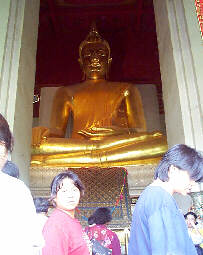
The head of Buddha image from Wat Thamikaraj. U-Thong style which featuring the image can be dated back to the period before the establishment of Ayutthaya Capital City
- To trace the remote existence of Thai in modern Thailand and to define their ethnical colonies since they
began to settle in this golden country, to define when and where they started to manifest their artisti activity in
relation to religion, and to state to what what extent they intermingled with the Lawas, Mon-Khmer and Malayan
races is not and easy task ; only our imagination may reconstruct the complex, long movement of the Thai
migration into Thailand, their assimilation of higher cultures, and finally their gradual independence merging
from the declinning powers among which they had lived for so many centuries.
- We may suppose that Indian colonies existed in Thailand since the beginning of the Buddhist Era. For
centuries these colonies influenced the less cultured peoples of Father India, an influence which went on for
more than one thousand and five hundred years. Afterwards, in the 13th century A.D. the Indian cultural
expansion was checked by the Muslim invation into India while Chinese power started to have an important
ascendancy over the people of Indochina. It is very important to remark that the Chinese influence found
cultures already firmly established, some of them even having already ended their historical cycle. Thailand
retained Indian culture, but because it emerged as an independent nation in the 13th century A.D. just when
the Chinese political power started to play important role, so many features of Chinese art are to be noticed in
the Thai one-this refers particularly to the polychromy of architecture, lacquer works, inlaid-mother of pearl works,
porcelain, and to some extent mural paintings.
- From Indian culture sprang up those of Dvaravati, (Mon people)
, Srivijaya, (Javanese) Khmer and Burm, Historically, the cultures of these people, except Burma, ran between the 5th to the 14th century A.D. Their religion was Hinayan or Mahayana Buddhism. Only
the Khmers followed alternatively either Hinuism or Mahayana Buddhism.

Phra Buddha Chinnarat, Wat Phra Si Rattana Mahathat, Phitsanulok
regarded as the most beautiful Buddha image in Thailand- Coming in contact with high civilizations, the animistic Thai adopted partially, if not totally, Buddhism. In what concerns art, we may presume the Thai started their activity in fusion with that of the Mon-Khmer and the Javanese of the Srivijaya period. Burmese influence over the indepndent northern Thai States must have been very important through King Anuruth's military conquests and his following pious and zealous spreading of Buddhism in the 11th century A.D. When the cultural and political cycle of the Dvaravati-Srivijaya and Khmer had reached its declining point, the Thai became the direct inheritors.
- I. From the 6th to the 10th century A.D. Dvaravati art saw its apogee. Influenced by Gupta examples, it developed many local schools spreading over central and north-east Thailand. From the 10th to the 13th century A.D. it followed its traditional non-creative activity. Nakhon Pathom was the capital of the Mon Empire, while Lavo (Lopburi), Suwanaphum (U-Thong), and Lamphun were the principal towns.
- II. From Chaiya, the then important port of south Thailand, Srivijaya culture spread up to the north of this country. In Lamphun the overlapping of the Dvaravati, Srivijaya and Khmer arts is noticeable. With reference to Srivijaya characteristics found in Lamphun and other northern towns, there are two theories : one is that the Srivijaya style was introduced in the north of Thailand by King Ramkhamhaeng of Sukhothai in the 13th century A.D. after his conquest of south Thailand ; the second theory is that Srivijaya art reached north Thailand in much earlier period. Considering the monuments having characteristics of the Srivijaya in the northern localities and considering the fact that King Ramkhamhaeng had no political influence over those northern towns, we could possibly accept the two theories corresponding to two distinct waves of Srivijaya influence : the first since about the 9th or 10th century and the second in the 13th century A.D.
- III. Khmer art, which alternatively represented either Mahayana Buddhism or Hindurism, is to be found all over central and north-east Thailand. It covers a period of about two hundred years ; 12th-13th century A.D.
- Khmer art had a great influence over the Thai one, so much that the Thai Nation rose over the declining Khmer power, hence directly inherited much of the Khmer culture.
- IV. As already stated, considering the geographical position of Burma in respect to north Thailand, we may understand how much the northern Thai art was influenced by that of Burma.
- V. In what concerns statuary, directly or indirectly, specimens of Buddha images of the Indain Pala art, 8th-12th century A.D., had certainly their shares in forming northern Thai statuary. Finally, we have to remember the continuous influence of other Indian specimens, particularly the great impules given by Ceylon to religion and art of Thailand.
- Coming in contact with high civilizations, the animistic Thai adopted partially, if not totally, Buddhism. In what concerns art, we may presume the Thai started their activity in fusion with that of the Mon-Khmer and the Javanese of the Srivijaya period. Burmese influence over the indepndent northern Thai States must have been very important through King Anuruth's military conquests and his following pious and zealous spreading of Buddhism in the 11th century A.D. When the cultural and political cycle of the Dvaravati-Srivijaya and Khmer had reached its declining point, the Thai became the direct inheritors.

The Buddha inmage of Wat Saphan Hin

The Phra Mongkol Bophit image, Wat Mongkol Bophit, Ayutthaya